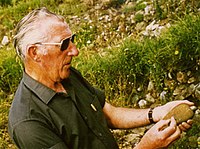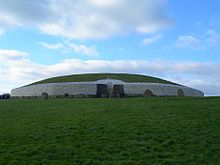Michael J. O'Kelly
Michael J. O'Kelly | |
|---|---|
 | |
| Born | 1915 |
| Died | October 1982 |
| Occupation | Archaeologist |
| Nationality | Irish |
| Notable works | Led excavation and restoration of Newgrange |

Professor Michael J. O'Kelly (1915 – October 1982) was an Irish archaeologist who led the excavation and restoration of Newgrange, a major Late Stone Age passage tomb in the Boyne Valley, County Meath, Ireland, now a UNESCO World Heritage Site.
Early life[]
O'Kelly was born in Abbeyfeale, County Limerick in 1915. Although he was baptized Michael Joseph, and published as Michael J. or M.J., he was known to family and friends as Brian, the name his mother originally wanted, throughout his life.[1] He entered University College, Cork (UCC) in 1934.
He began fieldwork as an undergraduate in 1937. He worked as a surveyor in the excavation of the ring-fort at Garranes, County Cork with Seán P. Ó. Ríordáin, then Professor of Archaeology at UCC. Later that year he moved on to the Neolithic site of Lough Gur.
After receiving his M.A. he was appointed curator of the new Cork Public Museum in Fitzgerald Park. In 1945 he married Claire, also an archaeologist, whom he had met as a student.[2]
Career[]
In 1946 O'Kelly succeeded Professor Ó Ríordáin as head of the Archaeology Department at UCC, a position he held for 36 years. He led field work each summer, and from 1944 was published extensively in scholarly journals.[1]
Newgrange[]
Newgrange, the site O'Kelly is most associated with, was originally accidentally discovered in 1699. It was in extremely poor condition in 1961, with no public access. That year the archaeologist Patrick Hartnett selected O'Kelly to direct excavations.[3] Work continued every season through to 1975.
On 21 December 1967 O'Kelly confirmed a local legend that the rays of the sun on the midwinter sunrise go straight through the tomb – passing through a small 'roof-box' opening above the doorway to penetrate along the whole length of the passage as far as the center of the chamber.[3] O'Kelly speculated: "I think that the people who built Newgrange built not just a tomb but a house of the dead, a house in which the spirits of special people were going to live for a very long time. To ensure this, the builders took special precautions to make sure the tomb stayed completely dry, as it is to this day. …"[4] O'Kelly and his wife also led work on other sites within the Boyne Valley complex.
Selected bibliography[]
- Irish Antiquity (1981)
- Newgrange: Archaeology, Art and Legend (1982)
- Early Ireland: An Introduction to Irish Prehistory (1989, posthumous)
Notes[]
- ^ Jump up to: a b O'Kelly, Michael J. (1989). Claire O'Kelly (ed.). Early Ireland: An Introduction to Irish Prehistory. p. xi. ISBN 0-521-33687-2.
- ^ "Professor Michael J. O'Kelly excavated and restored Newgrange". Newgrange.com. Retrieved 14 November 2010.
- ^ Jump up to: a b Harbison, Peter (1998) [First published 1988]. Pre-Christian Ireland: From the First Settlers to the Early Celts (paperback ed.). London: Thames and Hudson. ISBN 0-500-27809-1.
- ^ "Professor Michael J. O'Kelly excavated and restored Newgrange". Knowth.com. Retrieved 14 November 2010.
- 1915 births
- 1982 deaths
- 20th-century archaeologists
- 20th-century Irish people
- Irish archaeologists
- Irish scholars and academics
- People from County Cork